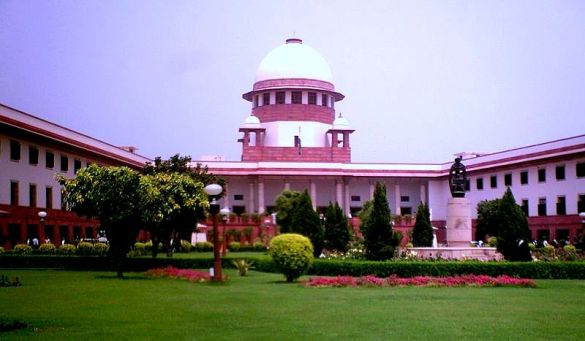
The Express cannot afford to shoot from the shoulders of the Supreme Court on a matter as polarising as affirmative action and mislead its readers. (Image: Wikipedia)
Many of the front page stories which featured last month in The Indian Express generated a nationwide response. Following the ink attack by Shiv Sena on former AB Vajpayee and LK Advani aide, Sudheendra Kulkarni, Express published a photograph of Kulkarni on the first page with the headline “Photo courtesy Shiv Sena” (October 13). The paper, edited by IITian Raj Kamal Jha, evoked a lot of buzz on social media owing to the creativeness and brevity which Express exhibited by aptly summarising Sena’s insane ink attack with the help of a subtle headline.
In another lead story, (dated October 16) titled “Muslims can live in this country but they will have to give up eating beef, says Haryana CM”, The Indian Express exposed the conservative mindset of Haryana chief minister Manohar Lal Khattar in an exclusive conversation. The 61-year-old leader’s remarks attracted intense criticism from political and social media circles.But the cover story run by the newspaper on the recent Supreme Court judgment concerning reservation in super specialised medical courses was an unlikely deviation from the high standards of reportage maintained by the publication.
The news report authored by IE‘s Utkarsh Anand was published with the provocative headline: “In national interest, scrap quota in higher education institutions: SC”. The lead paragraph of the report said, “Regretting that some ‘privileges remain unchanged’ even after 68 years of independence, the Supreme Court held Tuesday that national interest requires doing away with all forms of reservation in institutions of higher education and urged the Centre to take effective steps ‘objectively'”.
However, the news report then went on to contextualise the comments made by the Supreme Court, which were obviously in relation to a particular form of reservation vis-a-vis super speciality medical courses. If one peruses through the 58-page Supreme Court judgement delivered by Justices Dipak Mishra and PC Pant, one would find little evidence to claim that the Supreme Court directed the central and state governments to abrogate all forms of existing reservation in the realm of higher education.
On page 57 of the judgement, the Supreme Court referred to the case of one Fazal Ghafoor and quoted a previous judicial ruling which said: “In Dr Pradeep Jain case, this court has observed that in super specialities, there should really be no reservation. This is so in the general interest of the country and for improving the standard of higher education and thereby improving the quality of available medical services to the people of India. We hope and trust that the government of India and the state governments shall seriously consider this aspect of the matter without delay and appropriate guidelines shall be evolved by the Indian Medical Council so as to keep the super specialities in medical education unreserved, open and free.”
In this context, the court went on to add in succeeding point number 38 on pages 57 and 58: “The fond hope has remained in the sphere of hope though there has been a progressive change. The said privilege remains unchanged, as if to compete with eternity. Therefore, we echo the same feeling and reiterate the aspirations of others so that the authorities can objectively assess and approach the situation so that the national interest becomes paramount. We do not intend to add anything in this regard.”
Editorially, the Indian Express has a right to have a particular view on the reservation policy in higher education but that view has to be exhibited in the edit and opinion pages, instead of infiltrating into news reports on the front page. Nowhere, did the Supreme Court blatantly call for scrapping of reservations in higher education as theExpress headline claimed. All it disapproved of was reservations in super specialised medical courses and called upon the authorities to “objectively assess and approach the situation”.
The Press Trust of India copy on the Supreme Court judgement titled “SC reinforces no quota in super speciality courses” was far more responsible in its reportage of the ruling. Refraining from attributing any over the top comments to the Supreme Court, PTI’s lead said that “the Supreme Court has reinforced its earlier view that “there should really be no reservation” in super speciality courses in medicine in the general interest of the country.” PTI added, “It (SC) said at a time when the ‘privilege’ of reservation is ‘competing with eternity’ an objective assessment of the situation is required keeping national interest in mind”.
During a lecture held at my university, an editor of a long-form magazine described the Express as “a journalist’s newspaper”, a view echoed by many of my classmates since most of them happen to be its loyal readers. But, as it’s famously said, “with great power comes great responsibility”. The Express cannot afford to shoot from the shoulders of the Supreme Court on a matter as polarising as affirmative action and mislead its readers. Accuracy has to be maintained and a newspaper ought to refrain from reading too much into a judgement which simply talks about reservations in super specialised courses.
(This article was originally published in DailyO.)



